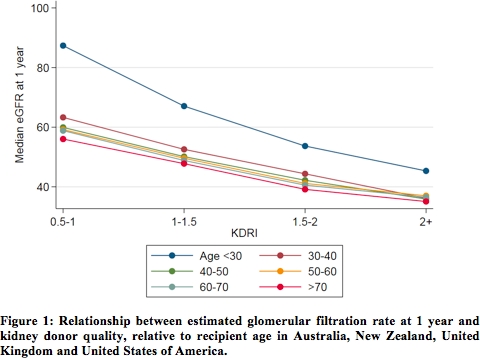Exploring the Impact of Recipient Age with Kidney Donor Risk Index and Estimated Glomerular Filtration Rate at One Year Following Kidney Transplant
1Australian and New Zealand Dialysis and Transplant Registry, Adelaide, South Australia, Australia
2Kidney Health Service, Royal Brisbane and Women's Hospital, Brisbane, Queensland, Australia
3Faculty of Medicine, The University of Queensland, Brisbane, Queensland, Australia
4Statistics Unit, Queensland Institute of Medical Research, Brisbane, Queensland, Australia.
Meeting: 2018 American Transplant Congress
Abstract number: B99
Keywords: Age factors, Donation, Glomerular filtration rate (GFR), Kidney transplantation
Session Information
Session Name: Poster Session B: Kidney Deceased Donor Allocation
Session Type: Poster Session
Date: Sunday, June 3, 2018
Session Time: 6:00pm-7:00pm
 Presentation Time: 6:00pm-7:00pm
Presentation Time: 6:00pm-7:00pm
Location: Hall 4EF
Background: Various kidney donor risk indexes (KDRI) have been developed to predict graft survival with various combinations of donor and recipient characteristics. The aim of this study was to;
Explore relationships between Rao KDRI and recipient estimated glomerular filtration rate (eGFR) at 1yr
Examine the impact of recipient age on eGFR at 1yr
Methods: A retrospective analysis of deceased donor and recipient data from Australian, New Zealand, UK and USA Organ Donor Registries was conducted from 2000-2015. Recipient age was categorised as <30yrs, 30-40yrs, 40-50yrs, 60-70yrs, >70yrs and KDRI was categorised into 4 groups (<1, 1-1.5, 1.5-2, >2). Median eGFR was calculated for the 24 combinations of age and KDRI.
Results: Overall, there were 6,512 Australian, 851 New Zealand, 21,077 UK and 157,664 American recipients (median age 52yrs, [IQR 41-61]). Recipients aged <30yrs receiving a good-quality kidney (KDRI<1.0) achieved a higher median eGFR at 1yr (87.4ml/min/1.73m2) compared with other age groups (median eGFR range: 56.0-63.3ml/min/1.73m2). Recipients aged <30yrs receiving an average-quality kidney (KDRI 1.0-1.5) yielded a better median eGFR of 67.1ml/min/1.73m2 compared with other age groups (median range: 47.8-52.6 ml/min/1.73m2). Recipients aged <30yrs receiving a marginal-quality kidney (KDRI 1.5-2.0) achieved a median eGFR of 53.7ml/min/1.73m2 compared with other age groups (median range: 39.2-44.4ml/min/1.73m2). Recipients aged <30yrs receiving a poor-quality kidney (KDRI>2.0) yielded a better median eGFR of 45.3ml/min/1.73m2 compared with other ages (range: 35.1-36.2 ml/min/1.73m2) (Figure 1).
Conclusions: As KDRI increases, eGFR decreases. Recipients aged <30yrs achieved a substantially higher eGFR at 1yr, independent of donor quality. Only small differences in median eGFR were seen between the other age groups.
CITATION INFORMATION: Chan S., Chatfield M., Baboolal K. Exploring the Impact of Recipient Age with Kidney Donor Risk Index and Estimated Glomerular Filtration Rate at One Year Following Kidney Transplant Am J Transplant. 2017;17 (suppl 3).
To cite this abstract in AMA style:
Chan S, Chatfield M, Baboolal K. Exploring the Impact of Recipient Age with Kidney Donor Risk Index and Estimated Glomerular Filtration Rate at One Year Following Kidney Transplant [abstract]. https://atcmeetingabstracts.com/abstract/exploring-the-impact-of-recipient-age-with-kidney-donor-risk-index-and-estimated-glomerular-filtration-rate-at-one-year-following-kidney-transplant/. Accessed December 23, 2025.« Back to 2018 American Transplant Congress

